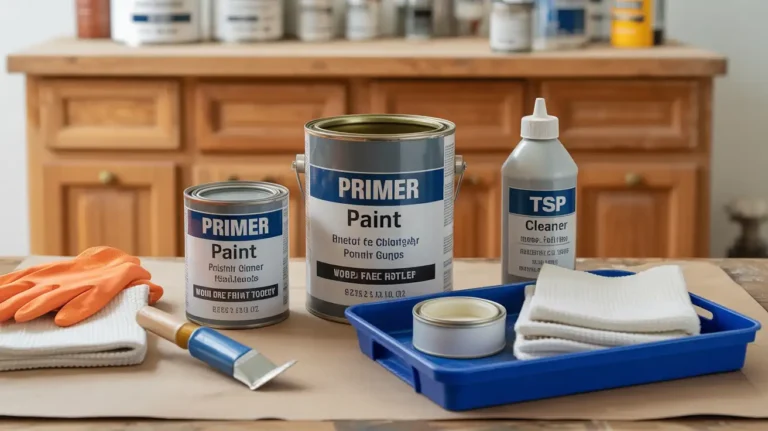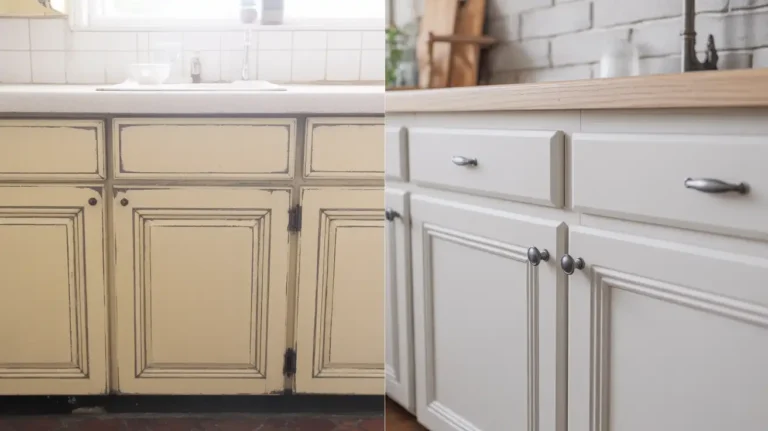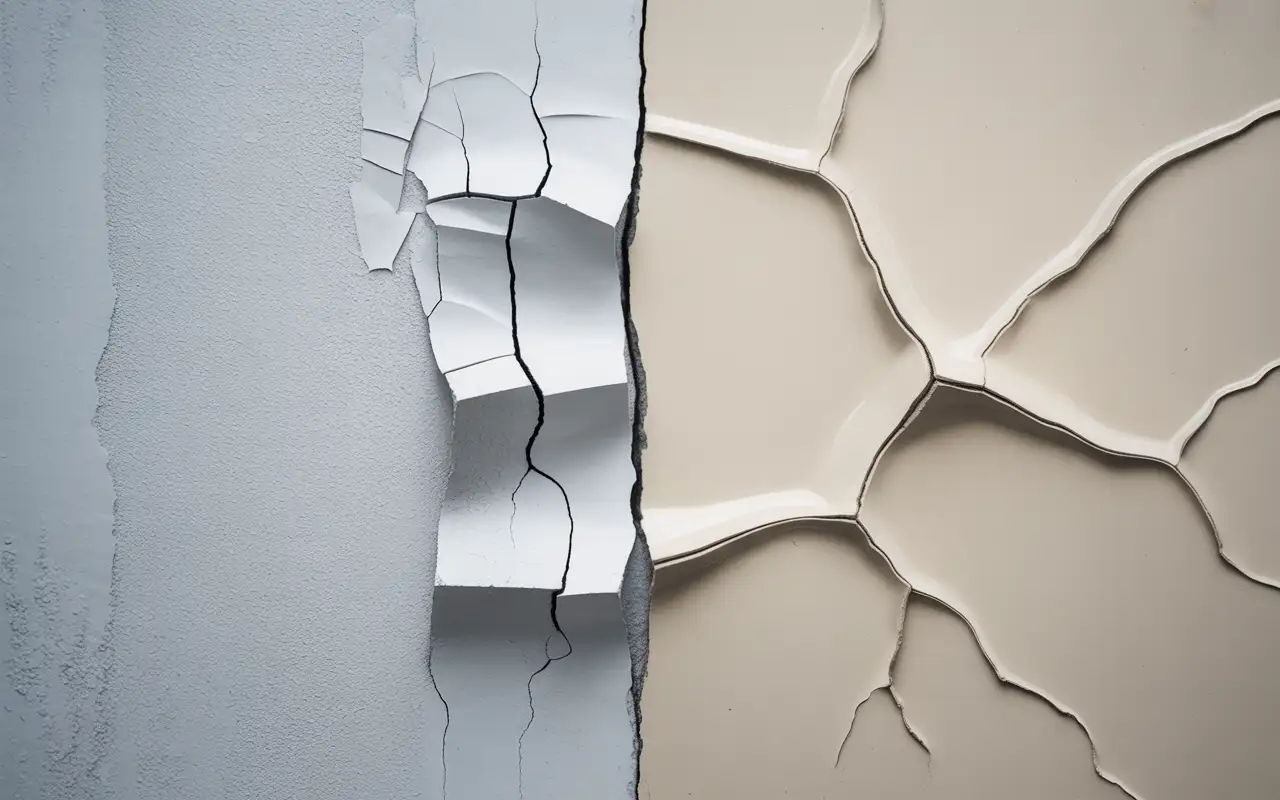If you want to rejuvenate an old kitchen without the high cost of a full remodel, painting the cabinets is a great choice. Outdated or worn laminate cabinets can make your whole kitchen look tired, but a new coat of paint is a budget-friendly solution. You can transform the entire look of your space in a single weekend with the right approach.
Many people ask, “How to Paint Laminate Cabinets?” The secret to success lies not in the final paint color, but in the meticulous preparation and choosing the correct materials. This comprehensive guide will walk you through every step, ensuring you achieve a durable, professional finish that will last for years.
Table of Contents
ToggleCan You Paint Laminate Cabinets?
Yes, you can paint laminate cabinets successfully. Laminate is a synthetic material with a smooth, non-porous surface that resists paint adhesion. However, with proper surface preparation and the right products, paint bonds firmly to laminate and creates a durable finish.
The key is understanding that laminate differs from real wood. Wood has natural texture and pores that grip paint. Laminate is slick and smooth, similar to plastic. You must roughen the surface and use specialized primers designed for laminate materials.
Most laminate cabinet painting projects fail because people skip critical prep steps. They clean quickly, skip sanding, or use standard wood primers. The paint looks good initially but chips and peels within months. Following the correct process ensures your paint job lasts 5 to 7 years or longer.
Professional painters charge $2,500 to $7,000 to paint kitchen cabinets, depending on kitchen size. DIY painting costs significantly less but requires 2 to 3 full days of work.
What You'll Need

Tools Required
- Cordless drill or screwdriver
- Fine-grit sandpaper (120 to 150 grit)
- Orbital sander (optional, for large kitchens)
- High-quality foam roller (4-inch size works best)
- Angled paintbrush (2-inch for detail work)
- Tack cloth
- Painter’s tape (2-inch wide)
- Drop cloths
- Dust mask or respirator
- Safety goggles
- Chemical-resistant gloves
- Small containers for screws and hardware
- Painter’s pyramids or cardboard boxes (for drying doors)
Materials Needed
- TSP cleaner or degreaser (like Krud Kutter)
- Laminate-bonding primer (Zinsser B-I-N or KILZ Adhesion)
- Paint for laminate cabinets (Benjamin Moore Advance or Sherwin-Williams ProClassic)
- Wood filler or laminate seam filler
- Mineral spirits (for oil-based products)
- Clean rags
- Small paint trays
Cost Breakdown
For an average 10×10 kitchen with 20 cabinet doors:
- Primer: $45 to $65 (1 gallon)
- Paint: $50 to $70 (1 gallon, 2 coats)
- Sandpaper and tack cloths: $15
- Cleaner/degreaser: $12
- Brushes and rollers: $25
- Tape and drop cloths: $20
- Miscellaneous supplies: $15
Total material cost: $200 to $250
Add another $100 to $150 if you’re also painting laminate furniture or bathroom cabinets.
How to Paint Laminate Cabinets in 5 Easy Steps

Step 1: Remove and Prepare Cabinet Doors
Start by removing all cabinet doors, drawers, and hardware. Use your drill to unscrew hinges from the cabinet frames. Place all screws, hinges, and handles in labeled containers so you know where everything goes during reinstallation.
Number each door and its corresponding cabinet opening using painter’s tape. Write matching numbers on both pieces. This simple trick saves hours of frustration when you reattach everything.
Set up your workspace in a garage or covered area with good ventilation. Lay doors flat on painter’s pyramids or create a drying rack using cardboard boxes. Never lean wet doors against walls as this causes drips and uneven coverage.
Clean every surface thoroughly with TSP cleaner or a strong degreaser. Kitchen cabinets accumulate cooking grease, food splatters, and oil from hands touching them daily. Mix your cleaner according to package directions and scrub all surfaces with a clean rag. Pay extra attention to areas near the stove where grease buildup is heaviest.
Rinse with clean water and let everything dry completely. Any remaining grease prevents the primer from bonding properly.
Step 2: Repair Damage and Sand the Surface
Inspect your laminate cabinets for chips, dents, or areas where the laminate is peeling. Fill small chips and dents with laminate seam filler or wood filler. Let the filler dry according to manufacturer instructions, then sand smooth.
If laminate edges are lifting, apply wood glue underneath and clamp or weigh them down until the glue dries. Painting over loose laminate leads to more peeling later.
Now comes the most important step: sanding. Laminate surfaces are extremely smooth and paint cannot grip them without roughening the surface first. Use 120 to 150 grit sandpaper and sand the entire surface lightly. You’re not trying to remove the laminate or sand down to bare wood. You just want to scuff up the glossy finish.
Sand in the direction of any wood grain pattern on the laminate. Use light, even pressure. An orbital sander speeds up this process for large kitchens but hand-sanding works fine for smaller projects.
After sanding, wipe down all surfaces with a tack cloth to remove dust. Even tiny dust particles cause rough spots in your final finish.
Step 3: Apply Bonding Primer
Primer is critical when painting laminate kitchen cupboards. Standard wood primers won’t work. You need a bonding primer specifically designed for slick surfaces like laminate, melamine, and thermofoil.
Top-rated primers for laminate include:
- Zinsser B-I-N Shellac-Based Primer (dries in 45 minutes)
- KILZ Adhesion High-Bonding Primer (water-based, low odor)
- Rust-Oleum Adhesion Primer (designed for plastics and laminates)
Pour primer into a paint tray. Use your foam roller to apply a thin, even coat to all cabinet doors and drawer fronts. Roll in long, smooth strokes to avoid roller marks. Use your angled brush for edges, corners, and detailed areas your roller can’t reach.
Apply primer to cabinet frames the same way. Take your time around hinges and inside corners where paint tends to pool.
Let the first coat of primer dry completely. Most primers dry in 1 to 2 hours but check your product label. Apply a second coat of primer for better coverage and adhesion. Two thin coats work better than one thick coat.
After the second primer coat dries, lightly sand with 220-grit sandpaper. This creates an ultra-smooth base for your topcoat. Wipe away dust with a tack cloth.
Step 4: Apply Paint
Choose paint designed for cabinets and trim. These paints dry harder than wall paint and resist chips and scratches. Best options for painted laminate cabinets include:
- Benjamin Moore Advance (water-based, self-leveling formula)
- Sherwin-Williams ProClassic (smooth finish, minimal brush marks)
- Rust-Oleum Cabinet Transformations (laminate cabinet paint kit)
Semi-gloss and satin finishes work best for cabinets. Semi-gloss is more durable and easier to clean. Satin provides a softer look with less sheen.
Use the same application technique as priming. Load your foam roller with paint and apply thin, even coats. Never over-load your roller as thick coats dry slowly and show roller marks.
Paint all doors and drawer fronts first. Let them dry for 4 to 6 hours before applying a second coat. Most laminate cabinet paint requires 2 to 3 coats for full coverage, especially when painting from a dark color to a light color.
Between coats, lightly sand with 220-grit sandpaper if you notice any drips or rough spots. Always wipe with a tack cloth after sanding.
Paint cabinet frames last. This gives door paint more time to dry and reduces the chance of smudging wet paint.
Step 5: Cure and Reinstall
Paint dries to the touch in a few hours but takes much longer to fully cure and harden. Most cabinet paints need 3 to 7 days to cure completely. During this time, avoid stacking doors or replacing hardware as the paint scratches easily.
After paint cures, reattach cabinet doors using your numbered labels. Start by installing hinges on the cabinet frames, then attach doors. Check that doors hang level and close properly. Adjust hinge screws if needed.
Replace drawer fronts and reinstall all hardware. If your old hardware looks dated, this is the perfect time to upgrade. New handles and knobs cost $3 to $15 each and dramatically update the look.
How to Paint Laminate Furniture
The process for painting laminate furniture matches the cabinet painting process with a few adjustments. Laminate dressers, bookcases, and tables all use the same synthetic material as fake wood cabinets.
Follow these steps to repaint laminate cabinets or furniture:
- Clean with TSP or degreaser
- Lightly sand with 120 to 150 grit sandpaper
- Apply bonding primer (2 coats)
- Apply paint for wood cabinets (2 to 3 coats)
- Let cure for one week before heavy use
Furniture experiences less wear than kitchen cabinets, so you can sometimes skip the second primer coat. However, using two coats ensures better durability.
Consider adding a clear topcoat for extra protection on high-use furniture like coffee tables or dresser tops. Water-based polyurethane in satin finish adds durability without yellowing.
The Real Cost to Paint Laminate Cabinets (DIY vs. Pro)
Painting your own laminate cabinets is significantly cheaper than replacing them or hiring a professional. Here is a breakdown of the estimated real cost for an average-sized kitchen (around 30 linear feet of cabinets):
Item | Estimated Cost Range (DIY) | Notes |
Primer | $40 – $80 | Shellac-based bonding primer (e.g., Zinsser BIN) is essential. |
Paint | $60 – $120 | One gallon of high-quality cabinet and trim enamel is usually enough for two coats. |
Sandpaper/Supplies | $30 – $50 | Fine-grit sanding sponges, tack cloths, painter’s tape, drop cloths. |
Tools | $20 – $50 | Foam rollers, quality brushes, degreaser (e.g., Sugar Soap, TSP substitute). |
Total DIY Cost | $150 – $300 | This is the cost for materials only, assuming you own basic tools. |
Professional Cost | $1,000 – $3,500 | This price varies widely based on kitchen size and regional labor rates. |
Choosing to repaint laminate cabinets yourself can save you thousands. The difference between a lasting result and a peeling mess is investing a little more in the correct primer and paint.
Common Mistakes to Avoid
Many DIY painting projects fail because of these errors:
- Skipping the cleaning step: Grease and dirt prevent the primer from sticking. Always clean thoroughly before sanding.
- Using wrong primer: Standard wood primer doesn’t bond to laminate. Buy primer specifically labeled for laminate, melamine, or slick surfaces.
- Over-sanding: Laminate is thin. Aggressive sanding damages the surface or sands through to the particle board underneath. Use light pressure and fine-grit sandpaper.
- Applying thick coats: Thick paint coats take forever to dry, sag, and show brush marks. Multiple thin coats create a smoother finish.
- Not allowing cure time: Paint that feels dry isn’t fully cured. Wait at least 3 days before reinstalling hardware and using cabinets normally.
When to Choose Professional Help
DIY cabinet painting saves thousands but requires patience and attention to detail. Consider hiring professionals if:
- You have a large kitchen with 30+ cabinet doors
- Your cabinets have intricate details or glass panels
- The laminate is damaged or peeling extensively
- You need the project done quickly
- You want a sprayed finish for ultra-smooth results
Professional cabinet painters use spray equipment that creates a factory-like finish impossible to achieve with brushes and rollers. They also complete projects faster because they have dedicated workspace and industrial drying equipment.
Update Your Laminate Cabinets With SD Custom Painting
While this guide on how to paint laminate cabinets covers all the necessary steps, the time, labor, and mess involved in a professional-grade paint job are significant. For homeowners in Southern California who want a flawless, spray-painted, chip-resistant finish without the headache, trust the experts.
If you are looking for top-tier cabinet painting services in San Diego, let San Diego Custom Painting handle the intensive prep, repair, and spraying. Our team uses industrial-grade equipment and specialized coatings to ensure a factory-like finish that dramatically transforms your kitchen overnight. Contact us today for a free estimate.
Final Thoughts
Learning how to paint laminate cabinets opens up affordable kitchen transformation options. This DIY project costs a fraction of cabinet replacement while delivering impressive results. The process requires patience and proper technique, but anyone with basic DIY skills can achieve professional-looking painted laminate cabinets.
Success depends on three factors: thorough surface preparation, using products designed for laminate, and allowing proper drying time between coats. Skip these steps and your paint will chip and peel. Follow them carefully and your cabinets will look great for years.
Start with a small project like a bathroom vanity or single cabinet to build confidence before tackling a full kitchen. The skills you learn apply to any laminate painting project, from furniture refinishing to built-in shelving.
FAQs
How long do painted laminate cabinets last?
Properly painted laminate cabinets last 5 to 7 years with normal use. Using high-quality bonding primer and cabinet-grade paint extends this lifespan. Avoid harsh chemical cleaners and scrubbing, which wear away paint faster.
What’s the best paint for laminate cabinets?
Benjamin Moore Advance and Sherwin-Williams ProClassic are top choices. Both are self-leveling formulas that minimize brush marks. They dry hard and resist chips. For budget-friendly options, Rust-Oleum Cabinet Transformations provides good results at lower cost.
Do I need to sand laminate cabinets before painting?
Yes, sanding is required. Laminate’s smooth surface prevents paint adhesion. Light sanding with 120 to 150 grit sandpaper roughens the surface just enough for primer to bond. Don’t skip this step or your paint will peel.
Can I paint laminate cabinets without removing doors?
You can paint cabinets in place, but results won’t be as professional. Removing doors prevents paint buildup in hinges and allows you to paint all surfaces evenly. It also eliminates drips from painting vertical surfaces.
How much does it cost to paint laminate cabinets?
DIY painting costs $200 to $600 for materials, depending on kitchen size. Professional painting runs $2,500 to $7,000. This compares to $8,000 to $20,000 for new cabinets, making painting an excellent value.
What primer works best on laminate?
Use bonding primers designed for slick surfaces. Zinsser B-I-N, KILZ Adhesion, and Rust-Oleum Adhesion Primer all work well. Never use standard wood primer on laminate as it won’t adhere properly.





